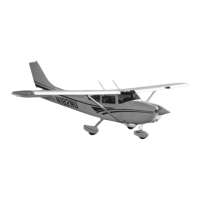SECTION 7 CESSNA
AIRPLANE AND SYSTEM DESCRIPTION MODEL T182T NAV III
GFC 700 AFCS
U.S.
ENGINE (Continued)
COOLING SYSTEM
Ram air for engine cooling enters through two intake openings in the
front of the engine cowling. The cooling air is directed from above the
engine, around the cylinders and other areas of the engine by baffling,
and then exits through cowl flaps on the lower aft edge of the cowling.
The cowl flaps are mechanically operated from the cabin by means of
the cowl flap control lever located on the right side of the control
pedestal and is labeled OPEN, COWL FLAPS, CLOSED. Any time the
control lever is repositioned, it must first be moved to the right to clear
the detent.
Before starting the engine, before takeoff and during high power
operation, the cowl flap control lever should be placed in the OPEN
position for maximum cooling. This is accomplished by moving the
control lever to the right to clear a detent, then moving the control lever
up to the OPEN position.
While in cruise flight, cowl flaps should be closed unless hot day
conditions require them to be adjusted to keep the cylinder head
temperature at approximately two-thirds of the normal operating range
(green band).
During extended descents, it may be necessary to completely close the
cowl flaps by pushing the cowl flap control lever down to the CLOSED
position.
TURBOCHARGING SYSTEM
Because the engine is turbocharged, some of its characteristics are
different from a normally aspirated engine. The following information
describes the system and points out some of the items that are affected
by turbocharging. Section 4 contains the normal operating procedures
for the turbocharged engine.
The following steps, when combined with the turbocharger system
schematic (Figure 7-5), provide a better understanding of how the
turbocharger system works. The steps follow the induction air as it
enters and passes through the engine until it is expelled as exhaust
gases.
(Continued Next Page)
T182TPHBUS-00
7-40

